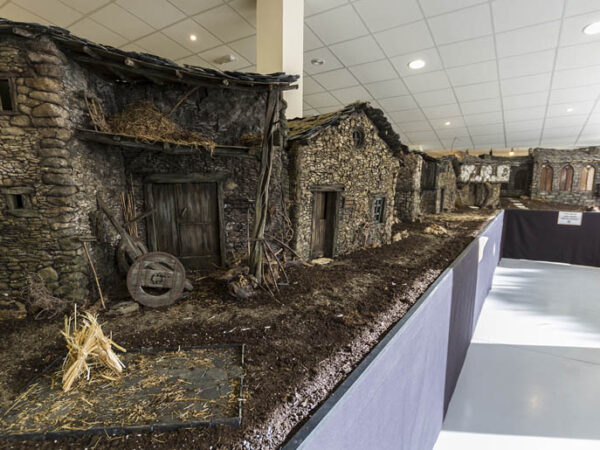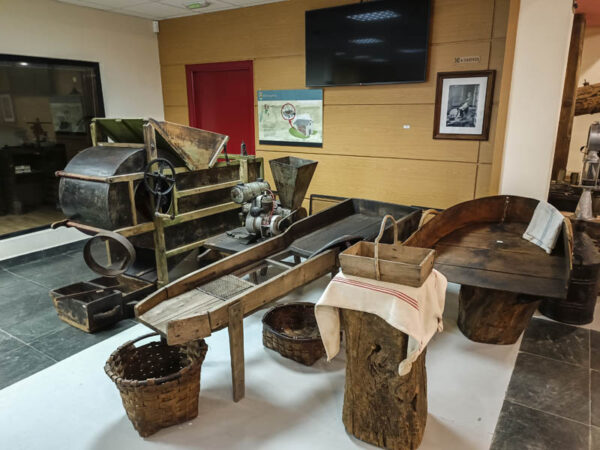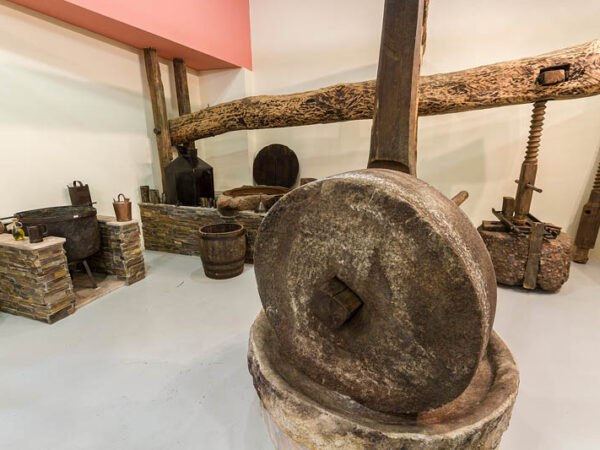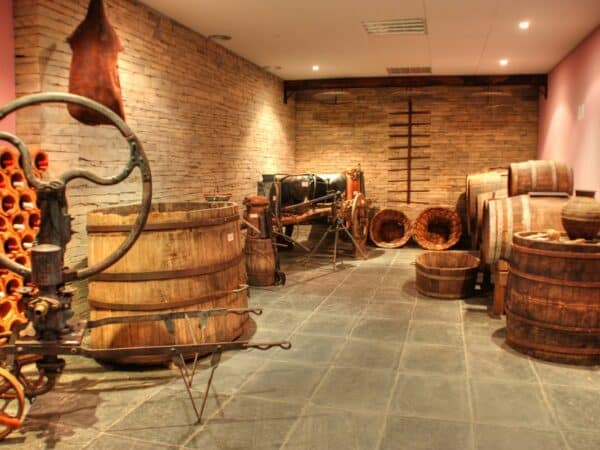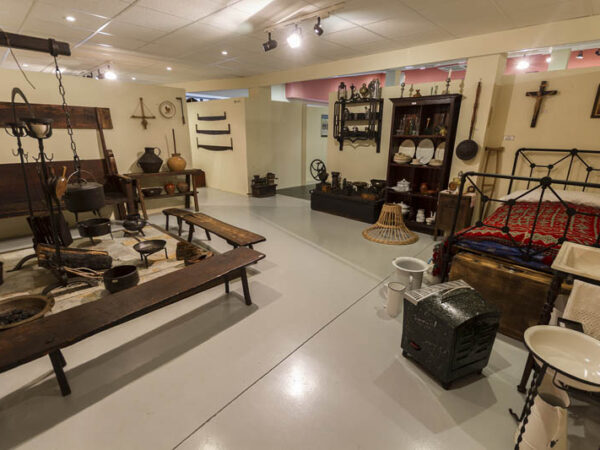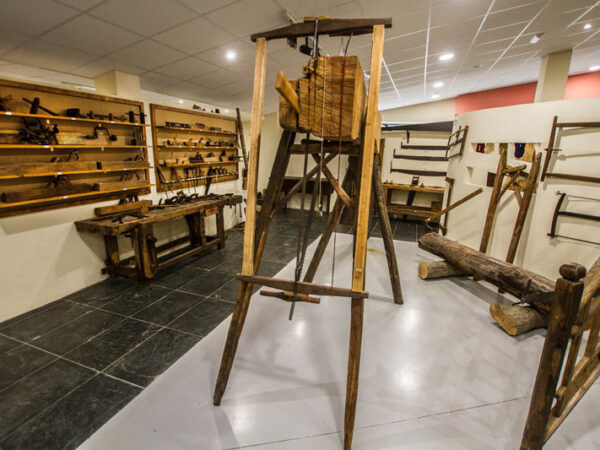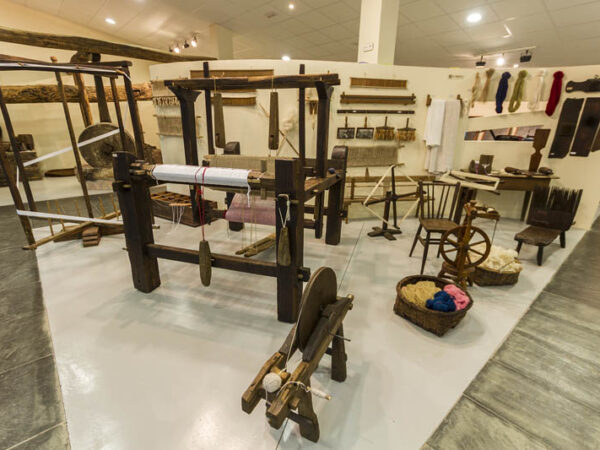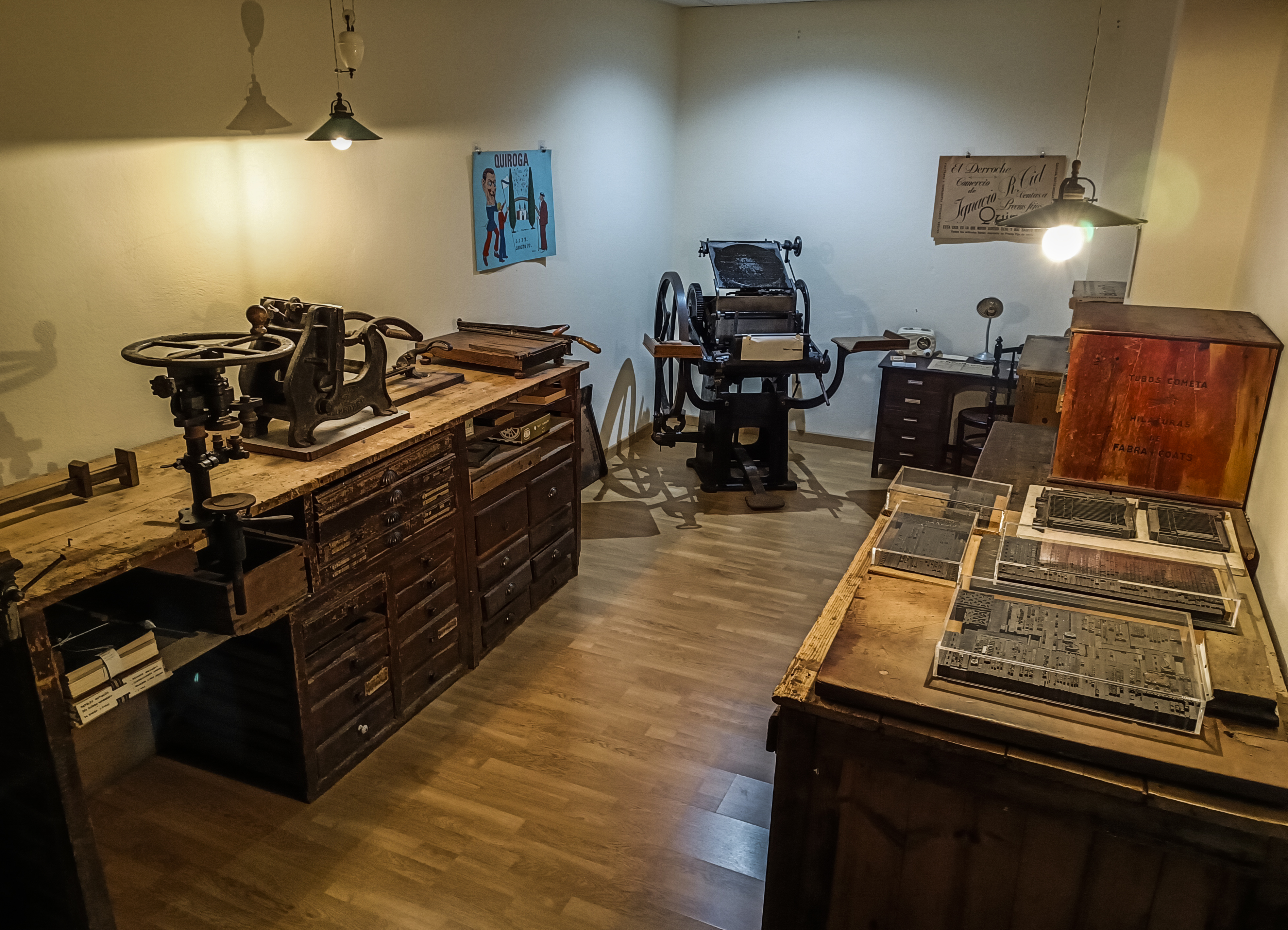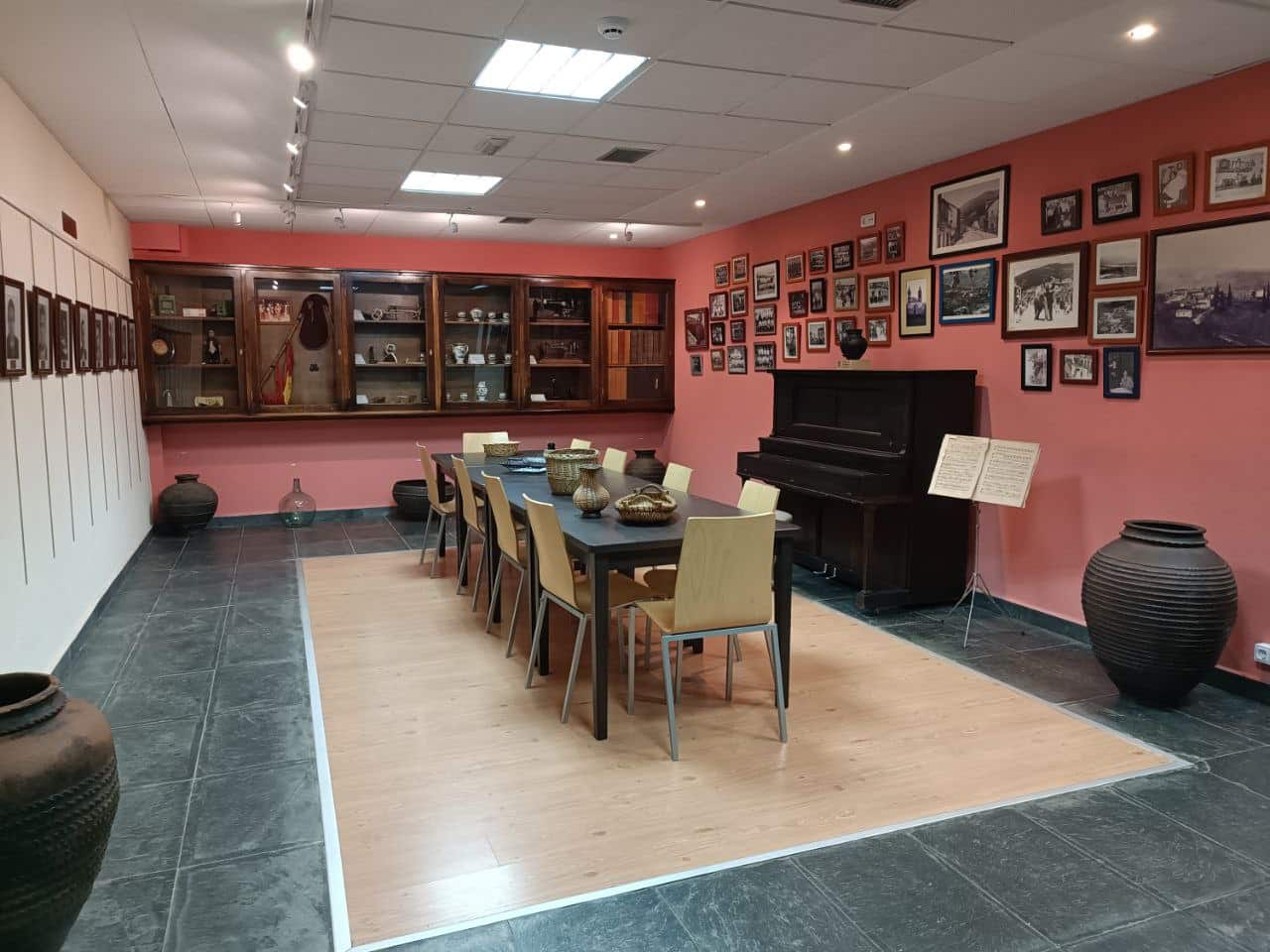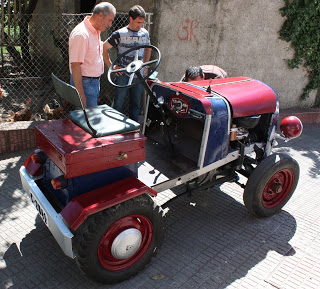All the contents present in this collection have their synthesis in the recreation of a typical village of these mountains with the exhibition of the models that were decorated in the Galician animated film “O Apóstolo”, by Artefacto Producciones; where stone, wood, iron, etc., find their place to facilitate the life of the people of this hard but grateful land. https://www.youtube.com/watch?app=desktop&v=4h7yoEMrL6A
Read moreethnographic pages
The Chestnut
Chestnut trees are still raised in their gloomy forests giving splendor to our landscape. This space is dedicated to something as ours as the process of driying the chestnut and its evolution until it is clean and ready to consume throughout the year Castiñeiros do val, meus castiñeiros orfos, vellos, calados e retortos, co toro podrecido, os brazos tortos, alá embaixo no río e nos outeiros. Estades desamparados e tristeiros, sodes medio pantasmas, medio mortos e, anque mucharon árbores e hortos, non fumegan sequeiros en Sequeiros. Fóronvos espulsando pouco a pouco, fóronvos desterrando paso a paso e acabarán quitándovos a vida. A penas sodes nada. Só salouco ou pinguiña de seiva envellecida que, amargamente, agarda o seu ocaso. Manuel María. Sonetos ao val de Quiroga.
Read moreThe Oil culture
Oil is a unique product of the lands of the river Sil that, due to their special climate, where the authentic native oil of Galicia has been made for millenniums. One of the great challenges for the Ethnographic Museum of Quiroga was to have in its facilities the machinery of a traditional oil mill, where could tell the oil´s history of these lands.
Read moreThe Honey culture
This product, which has always been very attached to the lands of the Geopark, did not stop evolving; production systems varied from the ancient cork oak barks to the modern multi-storeyed hives. They are presented in a very particular recreation of the unique circular beehives of stone which hundreds of them decorate our mountains.
Read moreThe Wine culture
The wine culture is historically related to the lowlands of the Courel Mountains , in the Sil river basin. In the room dedicated to this product, we can see the representation of a traditional winery with materials and utensils related to the whole wine cycle, from the care in the vineyard to the preparation of the brandy from the bagasse of the grape, once separated from the wine. Grape variety we can find in this area are: White Loureira, Treixadura, Godello, Dona Branca, Branco Lexítimo, Caíño Branco, Albariño e Torrontés. Red Mencía, Brancellao, Tempranillo, Sousón, Caíño Tinto, Caíño Longo, Caíño Bravo, Garnacha Tintureira, Mouratón, Gran Negro e Merenzao Wine culture has always been closely linked to Quiroga’s town. The craftsmanship of this product was always part of the daily life of the people of our region. Strains, just as the olive and chestnut trees are integrated into an unique landscape full of contrasts. O amplio val de Quiroga encaixase nunha das denominacións de orixe protexida de viños de Galicia coñecida como Ribeira Sacra, concretamente a subzona Quiroga-Bibei. Como se dí que o Miño leva a fama e o Sil a auga en Quiroga sucede algo similar pois a maior produción de viño da Ribeira Sacra producese nestas terras. Sendo así, en Quiroga podemos encontrarnos con diferentes bodegas pertencentes a denominación de orixe protexido:
Read moreThe School
The school was one of the latest additions to the exhibition of the Quiroga´s Ethnographic Museum. The recovery of several types of desks used in the old unitary schools of the territory, led to research in the villages searching the rest of the elements of the charming classrooms oin the early years of the twentieth century: blackboards, teacher’s desk, maps, toys, books, coal stoves… which shaped everyday lives of our people at school, loved and hated to the same extent.
Read moreThe kitchen below the bedroom
The kitchen below the bedroom is the heart of the traditional house, cooking place,the most important meeting point and the bedroom place of rest. We collect here a sample of the essential elements in these rooms.
Read moreThe Wood
The Museum collects the two main steps of woodworking: removing it from the forest and further processing by the carpenters. Boards were removed from the forest after harvesting with a sawing machine and cut out with a “machado”, the prepared tree trunk (squared and without branches or roots) was raised on top of the donkey, assisted by struts, saw men proceeded to saw it, with the air saw or the Portuguese saw, to obtain boards. Wooden planks that arrived to carpentries were transformed into all kinds of utensils, furniture, etc.
Read moreTextile Industry
Textile industry also has an important tradition in the Geopark, especially in the mountain parishes. Wool and linen were worked on numerous looms such as the one exhibited at the Quiroga Museum, where the tradition of traditional weavers is kept alive since its opening.
Read moreThe El Derroche store´s old printing
The El Derroche store´s old printing: Fabrics, clothing, footwear and stationery were its strong points, but El Derroche had the first funeral home, the first tobacco shop, providing electrical equipment and sale of phytosanitary products, modern toys and, of course, the first and only printing press of the Region.
Read moreThe tasting room
Multifunctional room dedicated about all to gastronomic products, located in the space that in these lands is known as “antebodega”. Many of the Valle del Sil wineries have a room in front of them that gives access to the interior; This space, which seeks to create a more stable temperature, independent of the outside temperature, is used as a meeting place for harvests, slaughters and other tasks throughout the year. Here, this arrangement also served us as a space to taste and learn about gastronomy, to house collections and unique pieces that need special protection.
Read moreSalvador Ontiveros Álvarez car
After four months of intense work and many setbacks, Salvador Ontiveros Alvarez´s car , (resident of Pacios de Mondelo, Quiroga), is now restored and exhibited at Quiroga´s Municipal Ethnographic Museum. On Monday August 10, 2009 at 1 p.m., coinciding with the most important fair of the year and the eighteenth “Mostra do Mel de Quiroga”, Salvador Ontiveros´ car ran again in Quiroga´s main street way to the Museum. The delivery was in an act in which his family, owner of the vehicle, made a symbolic presentation to Quiroga´s mayor for exhibition in the Ethnographic Museum. Salvador Ontiveros´ family had given the vehicle to the Ethnographic Museum one year ago, but so far not been possible to restore it due to lack of staff to carry out this work. For about three months, two assigned workers (Iván Vazquez Romero and Antonio Díaz de la Fuente), performed maintenance on the Ethnographic Museum, advised by the restorer of Agapito Vila´s Institution. They had to solve many problems to finally restore one of the first Quiroga´s cars. This single-seater vehicle is an unique car that does not belong to any particular business model, since it was built with parts from various sources by Salvador Ontiveros. He was a known neighbor of Pacios de Mondelo who died in 2002 at 103 years old, and that was known for his inventiveness and the many activities he played in his life. Salvador Ontiveros´ family gave, in addition to the vehicle, numerous pieces related to carpentry and a curious machine to make ice cream for exhibition and conservation in Quiroga´s Ethnographic Museum.
Read more
